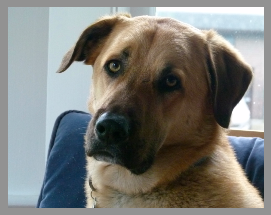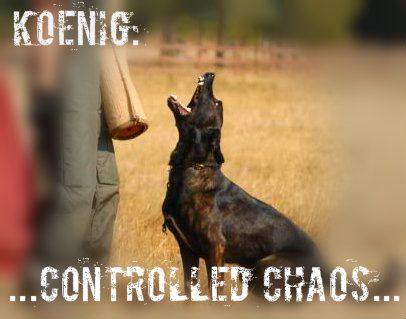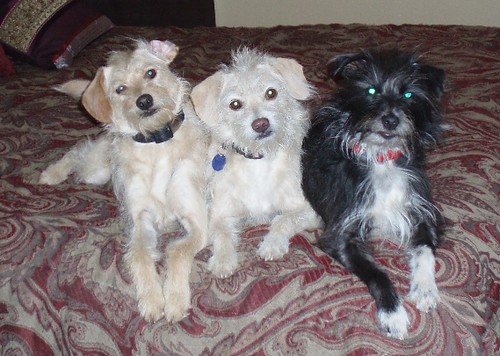I know every dog and every situation is unique, so I'm not sure Jethro's case will help, but I will share.
1. Clicker and treat training.
2. Nothing in Life is Free - training a default Sit and working on a default Down for everything (food, getting a toy or a bone, going through a door, moving forward in the environment.
3. Control Unleashed by Leslie McDevitt - especially the Look at That game, and all the recall games, Leave It game, we continue to work through her dvds one new game at a time.
4. Lots of walks where we are just ambling through the environment together, stopping to sniff, to investigate things. When Jethro gets too aroused by the smell of something I simply step on his leash and wait until he is finished with it. I think his nose gets tired of it, because he sits and looks at me to let me know he is ready to move forward. This is much easier than trying to get him away prematurely, he will be aroused by the smell and generalize that arousal to other objects in the environment. This way, when we move on, he is totally relaxed and my shoulder is still in my socket.
5. Lots and lots of clicks and treats for any and all eye contact, checking in, turning back to me.
6. Prong collar - I could not walk him without it.
7. Leashed in the house - there is always a way to calmly pick up the leash and take him to his crate.
8. Lots of crate time, in his own room at the back of the house where he is undisturbed. This is where he sleeps and gets his beauty rest. He rarely has a deep sleep anywhere else in the house, he is always on guard duty to some extent.
9. Calming Signals bonding behaviour. I get down to his level and extend my head and sniff with him (face only!), I let him come in under my neck and sniff my face. I call this 'affiliation behaviour', showing him we are his family pack.
10. A 12 ft. double sewn 1" web leash. This is super handy because I can give him a bit of roaming space as we walk and practice check in games, as well as allow it to drag on the ground and still have the handle in my hand so Jethro can get used to walking with me as if he was off leash. Also, I can stand on the leash when I have him in a Sit or a Down to make way for an elderly person or stroller on the sidewalk without him knowing and easily have the handle in my hands. This way, if he does make a move, he has the rock solid anchor of my foot, and he is getting used to not being able to move once his is in a Sit or Down, until he gets the okay.
11. In the house I am very careful to manage Jethro and Skipper's food and toys. No opportunities for resource guarding or stealing.
12. About the barking at things outside from the gated front porch or livingroom: we don't get angry anymore, or interpret his behaviour as 'disobedient'. We realize he is doing the best he can and when he goes over the top, we simply pick up his leash and move him to his crate because he can't handle the stimulation. No emotional energy to exacerbate the situation. Sometimes it is enough to say, "It's only such and such on the sidewalk. It's okay. Thank You. Settle." and he puts his head down and goes back to sleep.
13. Three to four walks a day, usually .45 - 1 hr. each. Lots of training on the walks, and play time, and just ambling, as well as some structured fast heeling as well. We play tug on the walk, too, I just drop his leash and bring out the tug toy. As long has he is fully engaged with me, we walk along with him jumping and tugging. Super fun.
14. Lots of affection when he is calm. Reminding him that he is our dog now, we are his family, he is with us.
15. Remaining calm no matter what. Jethro has a deep, throaty growl, and a huge, ferocious bark. I used to be afraid when I heard it. Now I laugh. He really has amazing vocalizations.
16. I cannot predict what is going to set off a reaction from the environment. There is no point in trying. I can predict the probability of a reaction by watching Jethro. One of my new games with him is to tighten up on the leash, and click and give him a treat. So he is associating the leash tightening (which I do sometimes when something is getting too close and I want us to get away quickly) with looking at me for a treat instead of looking around for something to warn off with barking and lunging.
17. No freedom in dog parks without very careful supervision. We use a long drag line up by the lake, and Jethro has a wonderful time charging through the swamp and fields. He is surprisingly good at playing with some dogs, I don't do any of that, but my husband has become very attuned to finding right sized, right aged dogs for Jethro to play with and that is when Jethro gets to go on a tear. With me, he has to survive with jumping, tug, and some running around playing soccer. His exercise is pretty much all interactive with me.
18. Lots of training and OB at any time. I like to challenge him with familiar tricks in more distracting situations, and teach him new tricks in low distraction situations. I really can't keep up with his ability to learn new tricks. But I try.
19. Raw diet, fed separately, no eye contact or inspecting each others bowls.
Gosh, that is about it for now! What I have learned as a dog handler is that there is no one formula that is going to solve a problem. It is always a composite of factors that I cannot predict. What I do is relax and trust that I am going to be able to handle whatever comes up, and then, because I am more relaxed, we have less to deal with. Jethro is highly attuned emotionally and responds to calm, fun, light happy, tone. He reacts badly to tension, fear, and anger.
My goal with Jethro is not to bend him to my will, but to tame him by coaxing, and over time, building his trust in my judgement, and willingness to follow me because that is the best idea he can think of.
 Previous Topic
Previous Topic Index
Index Next Topic
Next Topic













 Top
Top






.jpg)

